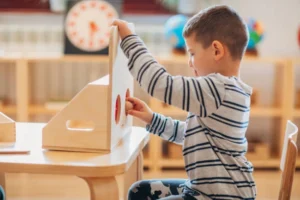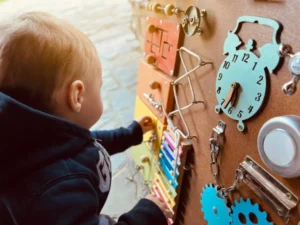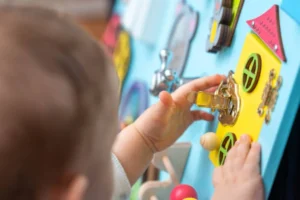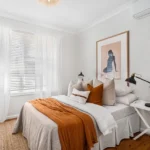Creating a Stable Baby Busy Board For Home, also recognized as movement boards, are fantastic tools for keeping babies interested while raising their fine mechanical abilities, problem-solving abilities, and sensory growth. Making a DIY Stable Baby Busy Board For Home allows you to convert it to your child’s comforts and needs and also use what you may already own!
Here’s a step-by-step lead to create a busy board For Home for babies, complete with thoughts for attractive and safe activities.

Protection a Stable Baby Busy Board For Home
If you are making a toy for your child, you want to make sure that it is safe. Be conscious of lesser items, if stuffs can easily become loose, harsh limits, pinch points, and other possibly unsafe threats. To confirm your child’s protection, your child should always be observed by a mature while playing with a DIY busy board and other toys you create for them.
Adding Engaging Elements and Stable Baby Busy Board For Home
I also inspiring you to shop your home first. You possibly have some fun stuffs putting around that you could repurpose. The zipper I used came from an outfit that didn’t suitable. The stitch counter was for binding, but I had not used it in years. We had a drawer pull and carabineer in our garage. Decorations were from my kids toy stash. The shoelace was not used an old shoe. The Velcro was from my sewing stash.

If you’re thinking nearly making a busy board, read few of my recommendations below and then start to keep an eye out for stuffs around your house, thrift stores, or a friend’s/family member’s home. Some of preferred recommendations are:
Locks and hangs
- Include a types of locks, such as padlocks, chain locks, and sliding bolts. These support grow problem-solving abilities and hand-eye coordination.
Light activity
- Attach a puck light, light button, or small fairy lights. Babies will love the cause-and-effect action of turning switches on and off.
Closure and Buttons
- Staple gun or stick zippers onto the board. Include big buttons on threads and buttonholes for extra fine motor practice.
Mirrors and Reflective places
- Minor, unbreakable mirrors or reflective sides can be attractive for babies and deliver visual stimulation.
Various tones Surface
Include various textures, such as sandpaper, felt, pompoms, textured stuff, and bubble covering, to improve sensory exploration.
Knot Tying activity
- Deliver a thread or shoelace to preparation binding shoe laces. This activity encourages skill and focus.
Musical Components
- Contain things that make noise, like minor bells or xylophone keys. These include an audio measurement to the busy board.
Memories of Themselves and Family moments
- At a young age, children love to see photos of themselves and persons they know. I made some out and used Madge Podge to adhere them to the board. I put them behind hinged doors and a tiny circle they can push to the side. Photos support with recognize relationships and memory.
Phases to Create Your DIY Busy Board For Home
Make the Board:
- You can purchase smaller boards at maximum local hardware stores. If you don’t have a saw, maximum stores will also suggestion to cut plywood down for you for free!
- If wood is holding you back from creating this scheme, you could also consider creating it out of a thick part of cardboard.
- Sand the boundaries and surface of the wooden board to confirm there are no rough spots or splinters. If you select to decorate the board, do so now and agree it to dry completely.

Organization the Design
Organize the things on the board to see how they appropriate together. Confirm there is sufficient space between each element for your child to manipulate them easily. Consider a mix of activities that involve different actions, such as rotating, sliding, flipping, and pressing.
Combine the Items
Use fixes, nuts, and rods to secure weightier things like door latches and buttons. For lighter things, such as zippers, use glue or pins. Make sure all items are definitely attached to the board and do not pose any choking risks
Making a DIY busy board for your child is a pleasing project that delivers endless hours of entertainment and learning. Customize it to your child’s interests and watch as they discover the joys of hands-on play.
Our busy board has been a family beloved and is normally played with whenever we have other kiddos over for play dates! I hope you like creation one too.
The perfect age for the Stable Baby Busy Board For Home
You can buy the Montessori busy board from 12 months to 4 years of age onward. It is a toy that develops with the child after his first year, and the child’s prefer to it will change as he nurtures. Thanks to the different actions involved on the panel, you don’t have to concern about your child being too young or too old if you are in the 12-36months limit anyway.
What your child will learn and improve their skills with a help of busy board
Each busy board can be a little different from another and it commonly has a specific concentration in terms of items. This toy is commonly concerned with to specific learning activities like: figures, shades, animals, words, letters and amounts. Some boards association various activities on the same toy while others are much more upright and concentrated on one item.

All busy boards commonly show a sensory portion that goals at the growth of hands-on abilities, focus and coordination. Those are activities that can start as soon as your child goes 12 months old and that effort near the maintenance of motor growth and learning that started with a baby gym. An example of this activity are leads that are involved and apart from the board by the baby, or even Velcro pull-offs that permit him to choose and place different items back onto the board. In this detail from Cherie wood’s busy board, the child will want to create a flower slide to complete the cactus image.
Conclusion
In adding to the sensory activity, there are the additional educational activities, which are commonly more difficult: in this case we range from something that can be a riddle that has to be put together or reunited to a sequence of geometric numbers that have to be placed in the board properly. If we are conversation about kids between the ages of 2 and 4, all those stuffs about animals, specifically if they do not yet identify all their names, and those that help them recognize the arrangement of letters to create words will be of concern to them.


